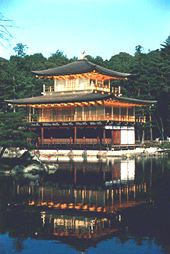Nearly 300 participants from around
the world will gather in Kyoto from November 30 to December 5, 1998, to
discuss ways to protect and preserve the common cultural and natural heritage
of our planet.
 They're
coming to attend the twenty-second
annual session of the World Heritage Committee. The committee will
decide what new sites should be added to the World Heritage List of
protected properties, evaluate the state of sites that are already on
the list, and talk about new joint efforts for the preservation of our
common heritage. This is the first time the meeting is being held in
Japan. They're
coming to attend the twenty-second
annual session of the World Heritage Committee. The committee will
decide what new sites should be added to the World Heritage List of
protected properties, evaluate the state of sites that are already on
the list, and talk about new joint efforts for the preservation of our
common heritage. This is the first time the meeting is being held in
Japan.
Representatives
of 21 governments, including Japan, sit on the World Heritage Committee.
The committee helps countries that have signed the World Heritage Convention
to preserve and protect the cultural and natural landmarks of lasting
value. The convention has been around since 1972, when it was adopted
at the General Conference of the United
Nations Educational, Scientific, and Cultural Organization (UNESCO).
The number of countries that have
signed the convention has reached 153, and over 550 properties are now
on the World Heritage List, including such natural sites as the Grand
Canyon National Park (United States), Great Barrier Reef (Australia),
and the Galapagos Islands (Ecuador), as well as cultural monuments like
Angkor Wat (Cambodia), the Great Wall of China, and the Taj Mahal (India).
Properties in Japan
 Japan
signed the convention in June 1992 and has six cultural and two natural
properties on the list: the Buddhist monuments in the area around the
temple Horyuji (Nara Prefecture), Himeji Castle (Hyogo Prefecture),
the ancient cedar forests of Yakushima Island (Kagoshima Prefecture),
the beech forests of the Shirakami Mountains (Aomori and Akita Prefectures),
historic monuments of ancient Kyoto, the historic villages of Shirakawa-go
and Gokayama (Gifu and Toyama Prefectures), and the Atomic-Bomb Dome
and Itsukushima Shrine in Hiroshima Prefecture. Japan
signed the convention in June 1992 and has six cultural and two natural
properties on the list: the Buddhist monuments in the area around the
temple Horyuji (Nara Prefecture), Himeji Castle (Hyogo Prefecture),
the ancient cedar forests of Yakushima Island (Kagoshima Prefecture),
the beech forests of the Shirakami Mountains (Aomori and Akita Prefectures),
historic monuments of ancient Kyoto, the historic villages of Shirakawa-go
and Gokayama (Gifu and Toyama Prefectures), and the Atomic-Bomb Dome
and Itsukushima Shrine in Hiroshima Prefecture.
A ninth property from Japan is expected to be added to
the heritage list at the Kyoto session this year: the historic monuments
of ancient Nara.
Buddhist
Monuments in the Horyuji Area
Horyuji is a Buddhist
temple that was built in the early seventh century by Prince Shotoku,
who played a big role in establishing Buddhism in Japan. The temple
consists of several wooden buildings--some of which are the oldest wooden
structures standing in the world today. In order to preserve them, they've
been dismantled and rebuilt every few hundred years. The temple holds
a valuable collection of Buddhist art, including masterpieces from the
Asuka period (593 to 710).
 Himeji-jo Himeji-jo
Himeji-jo (Himeji
Castle) is sometimes called the "white heron castle" because of its
majestic, white appearance. It was first built in the mid-fourteenth
century and rebuilt and expanded at the turn of the seventeenth century.
The castle has survived numerous natural disasters, including the Great
Hanshin Earthquake of January 1995, over its 400-year history.
Yakushima
Yakushima is a mountainous,
500-square-kilometer (190-square-mile) island off the southern coast
of Kyushu. At the center of the island is the 1,935-meter Mt. Miyanoura,
the highest peak in the Kyushu district. The island gets a lot of rainfall--anywhere
from 400 to 1,000 centimeters (160 to 390 inches) a year. Because of
the frequent rains and mountainous terrain, the island has very unique
plants. The most famous is a type of giant cedar called the yakusugi;
these cedars are some of the oldest trees on the planet.
Shirakami
Sanchi
The
Shirakami Sanchi (Mountains) stretch for almost 1,300 square kilometers
along the border of Aomori and Akita Prefectures in northern Japan.
The 170-square-kilometer (66-square-mile) beech forest is one of the
world's largest and is the home of the several rare and protected animal
species, including the golden eagle and black woodpecker.
Historic
Monuments of Ancient Kyoto
 The
historic monuments of ancient Kyoto are located in what are today the
cities of Kyoto, Uji, and Otsu. Heiankyo--Kyoto's ancient name--became
the nation's capital in 794 and remained so for over a thousand years
until 1868. Modeled after the capital of Tang China, it prospered as
the center of national culture under many emperors and shoguns. Countless
Buddhist temples and Shinto shrines were built in the city over the
years, and it's a treasure house of priceless cultural assets. The
historic monuments of ancient Kyoto are located in what are today the
cities of Kyoto, Uji, and Otsu. Heiankyo--Kyoto's ancient name--became
the nation's capital in 794 and remained so for over a thousand years
until 1868. Modeled after the capital of Tang China, it prospered as
the center of national culture under many emperors and shoguns. Countless
Buddhist temples and Shinto shrines were built in the city over the
years, and it's a treasure house of priceless cultural assets. 
Historic
Villages of Shirakawa-go and Gokayama
The historic
villages in the Shirakawa-go district in Gifu Prefecture and Gokayama
district in Toyama Prefecture are well known for their historical gassho-zukuri
(thatched-roof) farmhouses. The region gets a lot of snow in winter,
so the roofs are tall and steep to allow snow to slide off and prevent
the house from being crushed. These large farmhouses are divided into
three to four levels, some of which were used to raise silkworms or
make hand-molded paper during the winter months.
Hiroshima
Peace Memorial
The
Atomic Bomb Dome in the city of Hiroshima is what remains of the Hiroshima
Prefectural Industrial Promotion Hall after the world's first atomic
bomb to be used in armed conflict was dropped near it on August 6, 1945.
Originally built in 1915, the building has become a silent witness to
the tragedy of war and an enduring symbol of peace.
Itsukushima
Shinto Shrine
 Itsukushima
Shrine is built along the shore on Miyajima, a sacred island in Hiroshima
Bay. It was founded at the end of the sixth century and reconstructed
and expanded during the twelfth century by orders of Taira no Kiyomori,
the most powerful warrior-politician at the time. The shrine is built
so that much of it stands above water at high tide, making it appear
to be floating. The shrine has historically been known as one of the
three most scenic places in Japan, along with Ama
no Hashidate in northwestern Kyoto Prefecture and Matsushima
in Miyagi Prefecture. Itsukushima
Shrine is built along the shore on Miyajima, a sacred island in Hiroshima
Bay. It was founded at the end of the sixth century and reconstructed
and expanded during the twelfth century by orders of Taira no Kiyomori,
the most powerful warrior-politician at the time. The shrine is built
so that much of it stands above water at high tide, making it appear
to be floating. The shrine has historically been known as one of the
three most scenic places in Japan, along with Ama
no Hashidate in northwestern Kyoto Prefecture and Matsushima
in Miyagi Prefecture.
Photo: The Kinkaku, or Golden Pavilion, in the temple
Rokuon-ji in Kyoto. (Kyodo)
RELATED LINKS
The
UNESCO World Heritage Site
Ministry
of Foreign Affairs World Heritage Page
JIN Atlas
World Heritage Page

|
 They're
coming to attend the twenty-second
annual session of the World Heritage Committee. The committee will
decide what new sites should be added to the World Heritage List of
protected properties, evaluate the state of sites that are already on
the list, and talk about new joint efforts for the preservation of our
common heritage. This is the first time the meeting is being held in
Japan.
They're
coming to attend the twenty-second
annual session of the World Heritage Committee. The committee will
decide what new sites should be added to the World Heritage List of
protected properties, evaluate the state of sites that are already on
the list, and talk about new joint efforts for the preservation of our
common heritage. This is the first time the meeting is being held in
Japan. 
 Japan
signed the convention in June 1992 and has six cultural and two natural
properties on the list: the Buddhist monuments in the area around the
temple Horyuji (Nara Prefecture), Himeji Castle (Hyogo Prefecture),
the ancient cedar forests of Yakushima Island (Kagoshima Prefecture),
the beech forests of the Shirakami Mountains (Aomori and Akita Prefectures),
historic monuments of ancient Kyoto, the historic villages of Shirakawa-go
and Gokayama (Gifu and Toyama Prefectures), and the Atomic-Bomb Dome
and Itsukushima Shrine in Hiroshima Prefecture.
Japan
signed the convention in June 1992 and has six cultural and two natural
properties on the list: the Buddhist monuments in the area around the
temple Horyuji (Nara Prefecture), Himeji Castle (Hyogo Prefecture),
the ancient cedar forests of Yakushima Island (Kagoshima Prefecture),
the beech forests of the Shirakami Mountains (Aomori and Akita Prefectures),
historic monuments of ancient Kyoto, the historic villages of Shirakawa-go
and Gokayama (Gifu and Toyama Prefectures), and the Atomic-Bomb Dome
and Itsukushima Shrine in Hiroshima Prefecture. 


 Itsukushima
Shrine is built along the shore on Miyajima, a sacred island in Hiroshima
Bay. It was founded at the end of the sixth century and reconstructed
and expanded during the twelfth century by orders of Taira no Kiyomori,
the most powerful warrior-politician at the time. The shrine is built
so that much of it stands above water at high tide, making it appear
to be floating. The shrine has historically been known as one of the
three most scenic places in Japan, along with
Itsukushima
Shrine is built along the shore on Miyajima, a sacred island in Hiroshima
Bay. It was founded at the end of the sixth century and reconstructed
and expanded during the twelfth century by orders of Taira no Kiyomori,
the most powerful warrior-politician at the time. The shrine is built
so that much of it stands above water at high tide, making it appear
to be floating. The shrine has historically been known as one of the
three most scenic places in Japan, along with